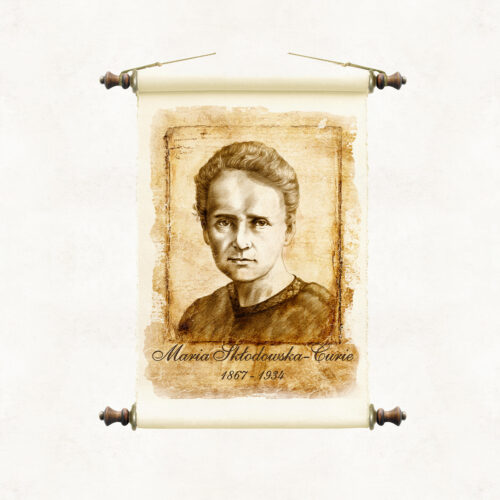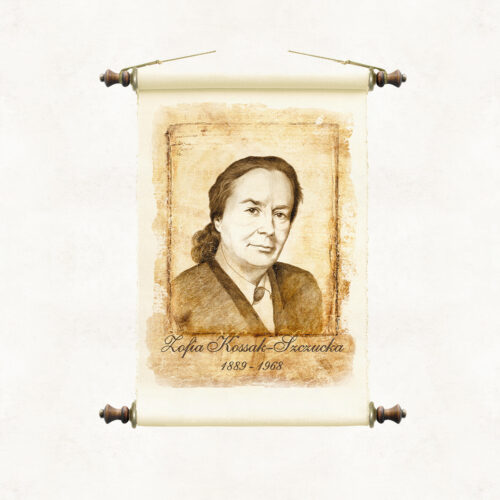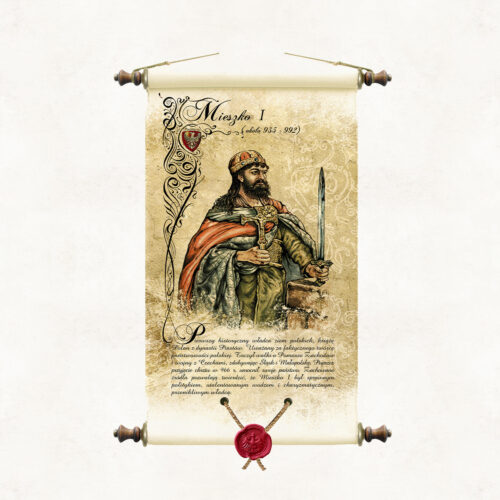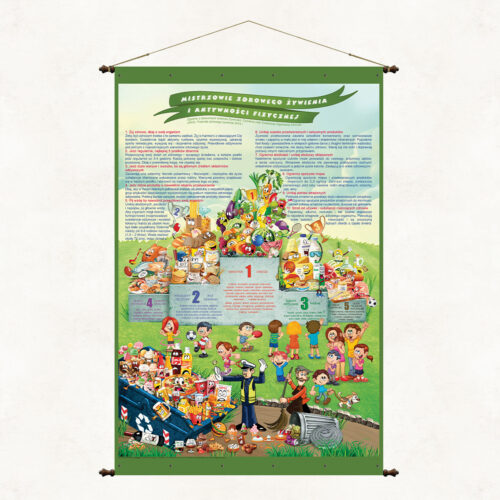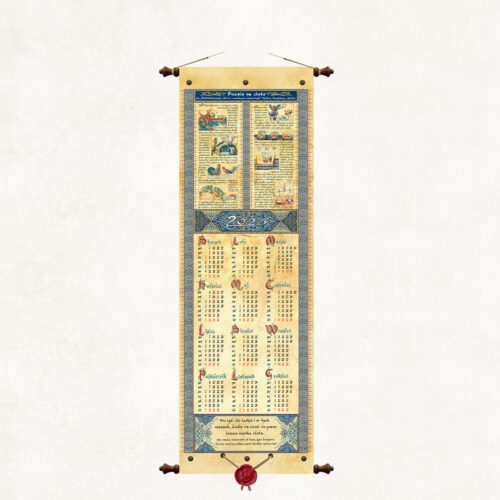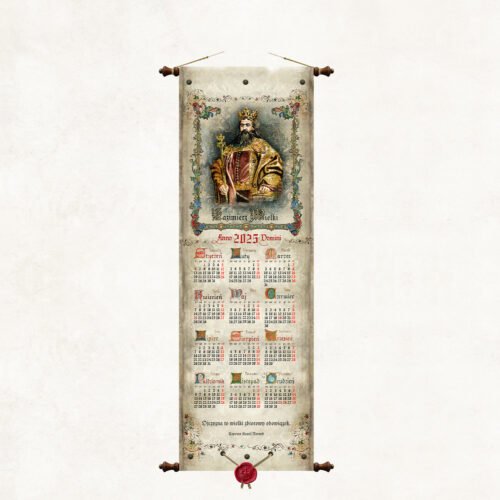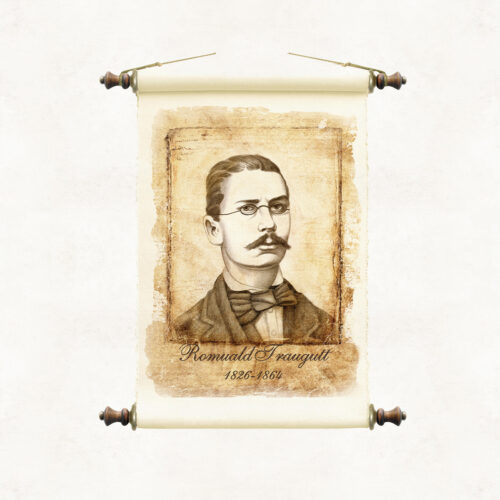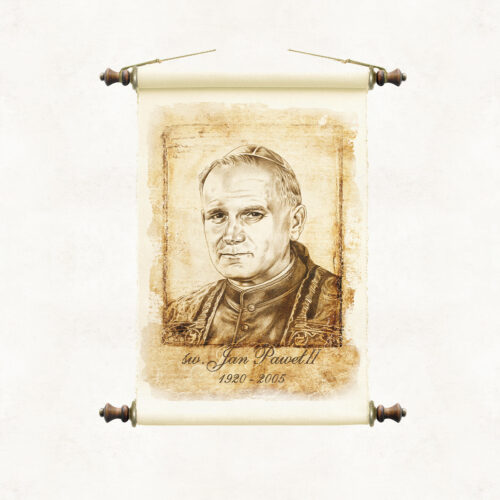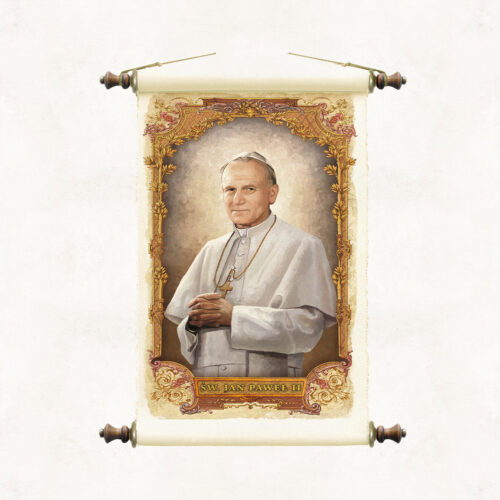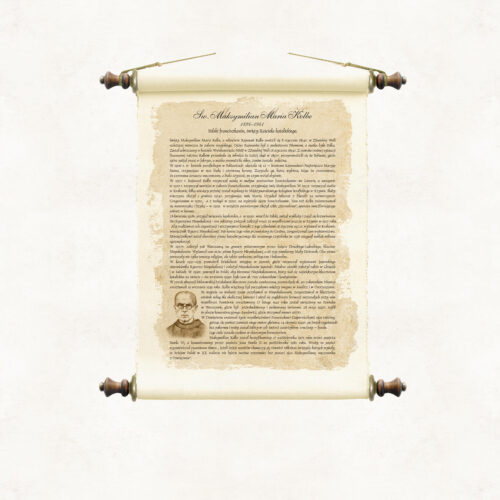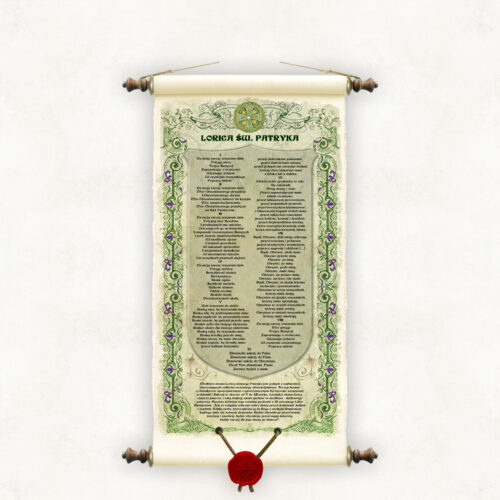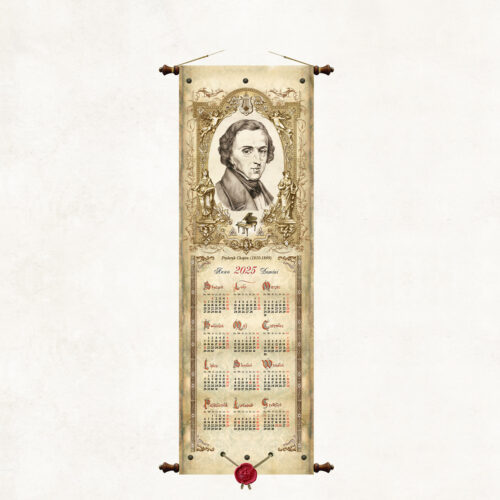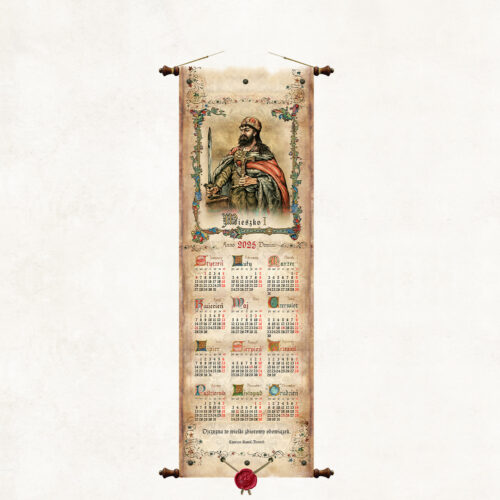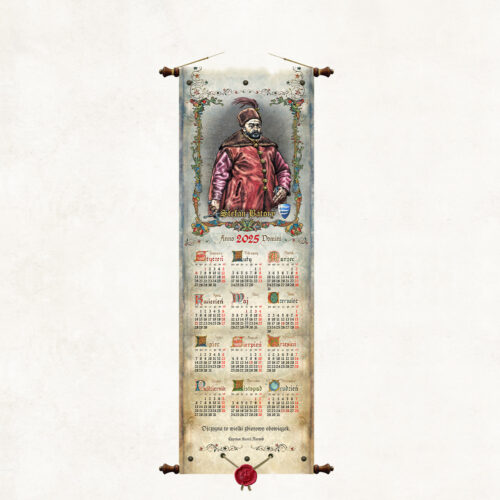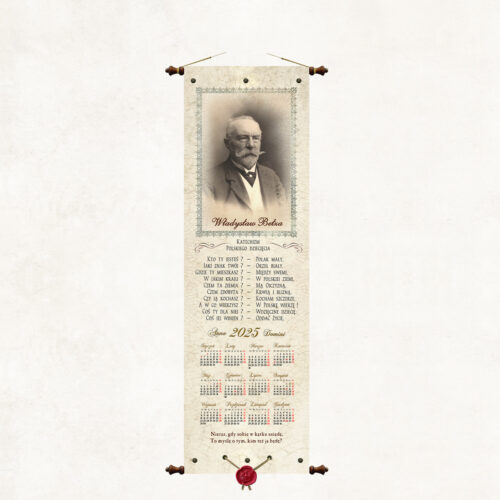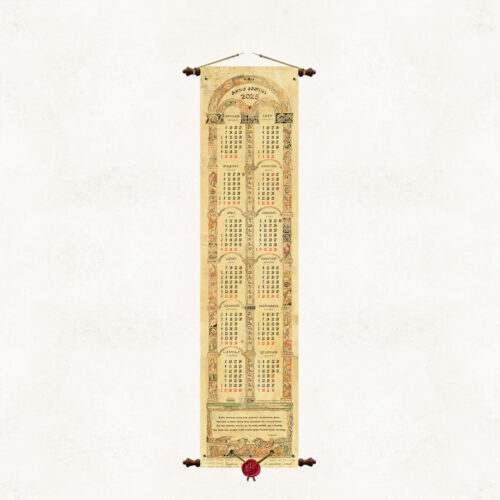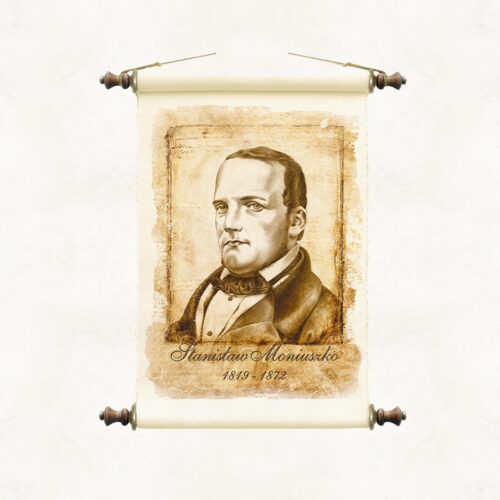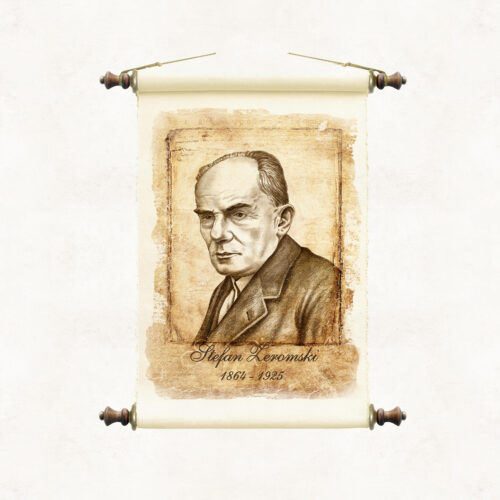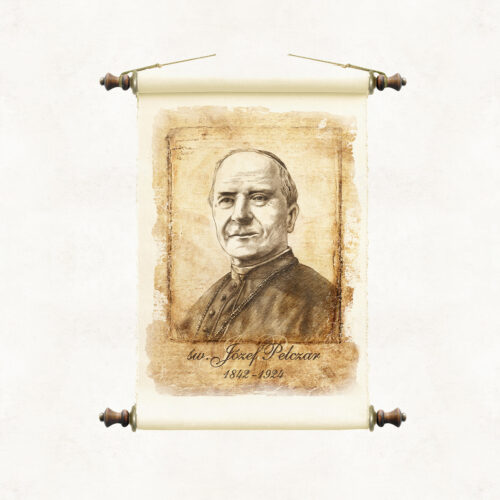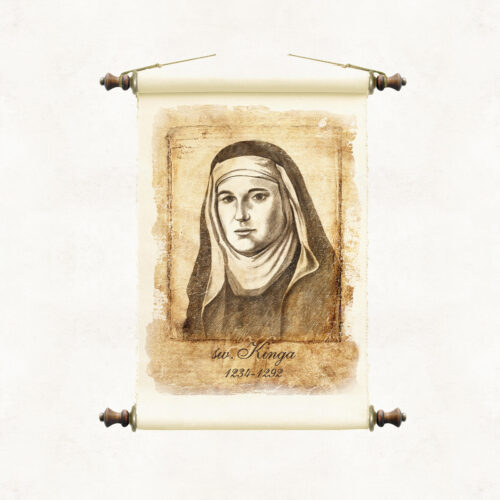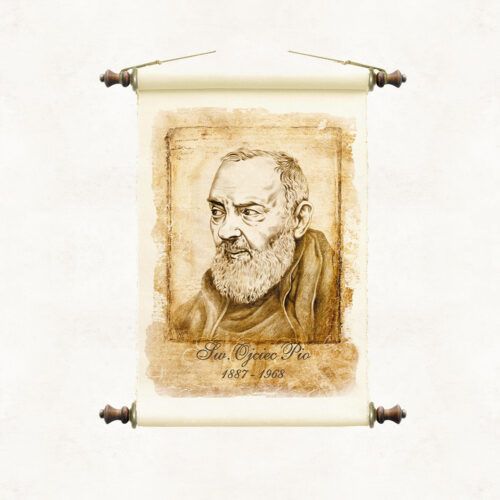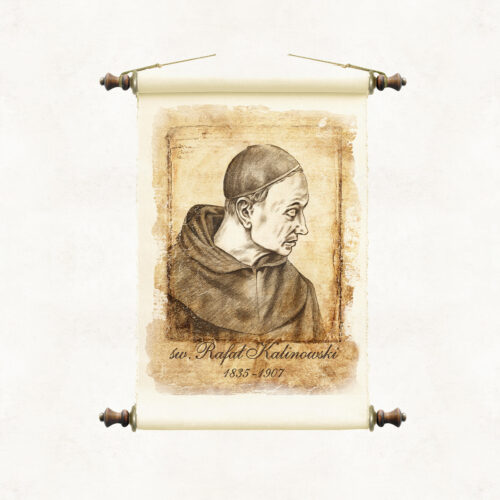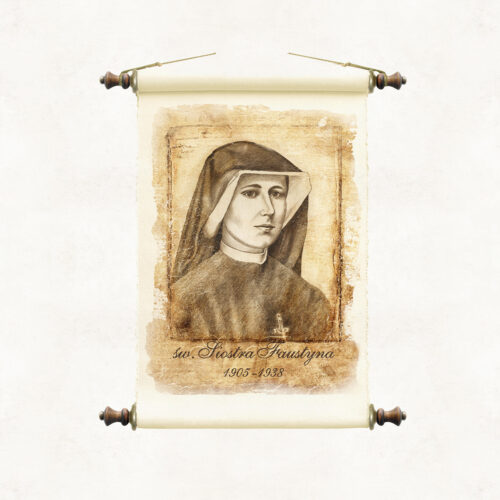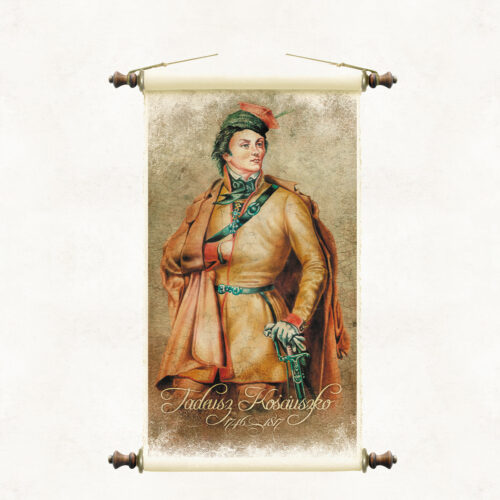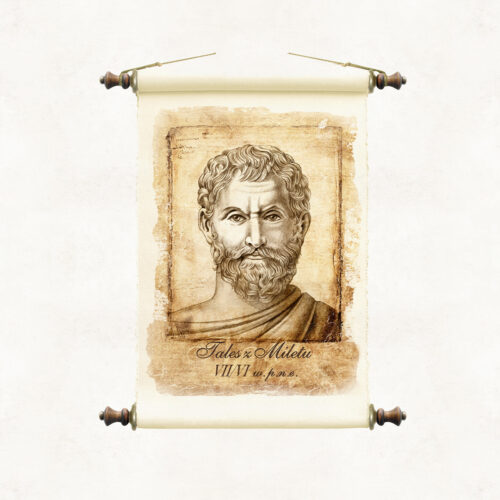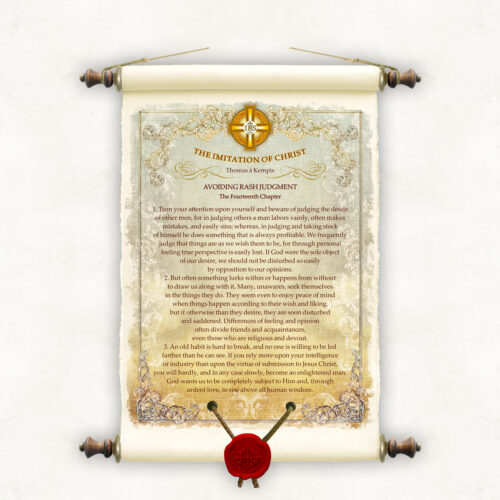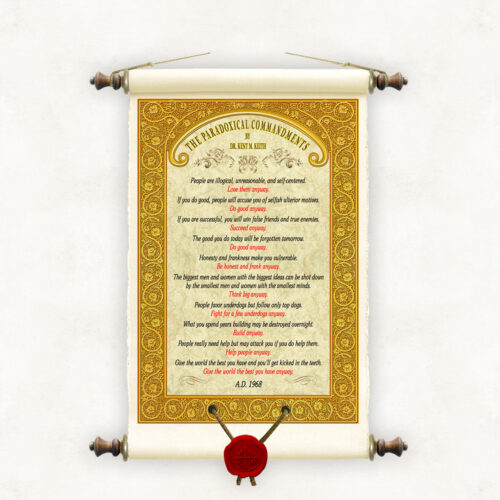-
Scroll with an image of Prince Casimir the Restorer, painted in watercolour by the artist of our publishing house, Marek Miha. The portrait is a colourful interpretation of drawings from the series Poczet królów i książąt polskich (A Selection of Polish Kings and Princes) made in pencil by Jan Matejko. KAZIMIERZ THE RENEWER (1016 - 1058) Casimir Charles I, more commonly known as the Restorer, ruled Poland from 1039 to 1058. He failed to take power after his father Mieszko II, was exiled, and the country descended into chaos. In 1039, the Restorer returned to the country and, with the help of the German Emperor and a Ruthenian prince, gradually regained power, rebuilt the country, recreated the ecclesiastical metropolis and made Krakow the new capital. However, he was no longer able to regain the royal crown.
-
MIESZKO I (922-992) The first historical ruler of the Polish lands, the actual creator of the Polish statehood. A skilful politician and a talented leader. He fought battles for Western Pomerania and wars with Bohemia, conquering Silesia and Lesser Poland. By being baptised in 966, he strengthened the state, putting it on a par with the Christian countries of Europe. He established a Polish bishopric in Gniezno, and initiated the construction of numerous fortified towns and churches.
-
The nutrition board "Champions of healthy eating and physical activity" is a verbal and graphic illustration of the principles of healthy eating. This is an innovative scheme that groups food products and presents them in the form of a sports podium with a very clear evaluative division. Unlike the popular food pyramid scheme, which is not very suggestive for young people, our original board presents the healthiest products in a fun and clear way in the first and subsequent places on the podium. Unhealthy or even harmful dishes were pointedly placed in the garbage. The graphic message is complemented by ten essential principles of healthy eating placed at the top of the publication.
-
The calendar contains an alchemical, medieval recipe for gold from the "Collection of recipes for various arts" - Schedule diversarum artium, Theophilus Presbyter (ca. 1070-1125). The schedule allows for a detailed familiarization and analysis of the techniques of artistic crafts in the Middle Ages. The work is divided into three volumes. The first volume contains information on techniques, production and use of materials for drawing and painting, the use of paint and ink, especially for book painting and wall painting. The second volume concerns stained glass and stained glass technique. The third volume is devoted to goldsmithing and it is there that the oh-so-"practical" recipe for gold is given.
-
CASIMIR THE GREAT (1310 – 1370) The last of the Piast dynasty, king of Poland from 1333. Due to his talented foreign policy and the small number of wars fought, he was called the "diplomatic king" and "he who found Poland wooden and left it brick", due to the construction of dozens of new cities and expansion or building several hundred new castles and fortresses. His reign actually consolidated the process of unification of Polish lands and led Poland out of political isolation in Europe, after nearly two centuries of division.
-
The prayer called Saint Patrick's Breastplate is one of the most interesting relics of early Christianity. This type of hymn of an apotropaic and exorcistic nature was widely used in Ireland and Scotland between the 5th and 12th centuries. The prayer is meant to act as a spiritual armor. A specific definition of the term comes from the 11th-century Liber Hymnorum: “It is a religious protection of body and soul against demons, men and vices. Any person who sings it to God with great concentration, every day, will not see demons. It will protect him from every poison and envy, he will be protected from sudden death, and it will be a shield for his soul after death.”
-
The board commemorates Saint. Stanisław of Szczepanów (also Stanisław Szczepanowski), bishop of Krakow, martyr, saint of the Catholic Church and one of the main patrons of Poland. The illumination placed on the board shows Saint. Stanisław as the patron saint of the Kingdom of Poland and comes from the work of Jan Długosz entitled Catalog of the Archbishops of Gniezno (Latin: Catalogus archiepiscoporum gnesnensium) from before 1476. The author of the painting is the Cistercian Stanisław Samoshootnik, a. Stanisław of Mogila (1480 - 541) - Polish painter, illuminator and miniaturist. The illustrations for the catalog were made several dozen years after Jan Długosz's death.
-
BOLESŁAW CHROBRY (967 - 1025) Son of Mieszko I, the first crowned king of Poland. He was an ally of Emperor Otto III, whom he hosted in Gniezno in 1000. He led victorious wars for Milsko and Lusatia. He organized missionary trips to Kyiv. He placed his son-in-law Svatopluk on the Russian throne and regained the Cherven Castles, previously occupied by Prince Vladimir of Kiev, annexing them to his state. Historians are increasingly adding the word "Great" to his name.
-
Fryderyk Franciszek Chopin (1810 - 1849) Fryderyk Chopin (French: Frédéric Chopin), Polonized form: Szopen (born February 22 or March 1, 1810 in Żelazowa Wola, died October 17, 1849 in Paris) - Polish composer and pianist. From October 1831 he lived in France. He is considered one of the greatest Romantic composers, as well as one of the most important Polish composers in history. He was one of the most famous pianists of his time, often called the poet of the piano. Elements characteristic of Chopin's works are in-depth expression and drawing on the stylistic patterns of Polish folk music.
-
MIESZKO (922–992) The first historical ruler of Polish lands, the actual creator of Polish statehood. An efficient politician and a talented leader. He fought for Western Pomerania and wars with the Czechs, conquering Silesia and Lesser Poland. By being baptized in 966, he strengthened the state, equaling it with the Christian countries of Europe. He established a Polish bishopric in Gniezno and initiated the construction of numerous defensive strongholds and churches.
-
STEFAN BATORY (1533 -1586) Son of Stefan, voivode of Transylvania, and Katarzyna Telegdi. From 1571, prince of Transylvania, and from 1576, second elective king of Poland. At great financial expense, he organized an army and conducted three victorious campaigns against Moscow (1579, 1580, 1581), capturing Polotsk, Velikiye Luki and besieging Pskov. The war with Russia ended with the truce in Jama Zapolski, strengthened the rule of the Polish-Lithuanian Commonwealth in Livonia and expanded the borders of Lithuania.
-
Scroll calendar - Władysław Bełza Władysław Bełza (born October 17, 1847 in Warsaw, died January 29, 1913 in Lviv) - Polish neo-romantic poet, writing in a patriotic spirit, called the eulogist of Polishness. Publicist, animator of cultural, educational and press life, co-founder of the Polish educational organization Macierz Polska. Author of, among others, the famous patriotic poem "Catechism of a Polish Child" which begins with the words Who are you? - Little Pole...
-
The educational board Student of Our School presents patterns of good features, attitudes and behaviors of students.
-
The Imitation of Christ (Latin: De imitatione Christi) - a popular book-guide to the Christian life written before 1427. The authorship of the work is attributed to Thomas à Kempis, although this is not definitively established. The book is a practical guide dedicated to Christians who, desiring salvation, walk in the footsteps of Christ. The Imitation of Christ is also the most popular ascetical work in the history of literature with a universal appeal beyond the Christian religion. The work consists of independent books and chapters containing instructions and wisdom on various aspects of the human quest for a worthy life. We offer you an original series of publications containing selected excerpts from this famous book. The form and charter of the work allow for random reading of individual chapters without direct reference to other parts of the work. Thus, we offer selected separate excerpts from the book, according to your tastes and needs. The themes and scrolls presented on our site are only an illustrative visualization of the series. To your order we will make any fragment of the book, provided that its size does not exceed a standardized page, that is, about 1800 characters with spaces and special characters. In selecting the text fragment you are interested in, we suggest using the study on the page : https://www.leaderu.com/cyber/books/imitation/imitation.html
-
The Paradoxical Commandments This piece was written by Kent M. Keith in 1968 as part of a booklet for student leaders. In the Polish version it is known under the title Mimo wszystko (Anyway). Its content inspired the name of the Anna Dymna Foundation - Mimo wszystko. The Paradoxical Commandments, contrary to their name, are not really paradoxical at all, they are in their essence commandments of love, and such a title would best convey the meaning of the piece. Their profound content and message are de facto a practical interpretation of the Hymn of Love from (1 Corinthians 13). They are indications of how to fill human life with love in order to live with dignity. After reading the commandments, after all, a fundamental question irresistibly imposes itself. In the name of what should we act so paradoxically? The answer is one and is found in the Bible, in the name of love, for God is love (1 John 4). The author does not give us this obvious answer directly. What's more, throughout the text he consciously and consistently does not refer to God even once, although we can feel His omnipresence in the text. The number of commandments referring to the Decalogue does not seem to be accidental either. This fact meant that the text cannot be classified as a publication from the ranks of naive religious instruction. The rest was done by the eternal human transcendent longing for truth, love, and the absolute. It made the Paradoxical Commandments immensely popular and, as the author himself writes, “For more than 50 years, the Paradoxical Commandments have circled the globe. They have been put on walls and refrigerator doors, featured in speeches and articles, preached from pulpits, and shared extensively on the web. They have been used by business leaders, military commanders, government officials, religious leaders, university presidents, social workers, teachers, rock stars, parents, coaches, and students. Mother Teresa thought the Paradoxical Commandments were important enough to put up on the wall of her children’s home in Calcutta.”

